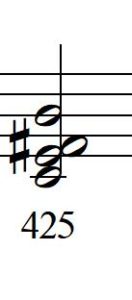The ‘four notes chords’ concept was introduced to E-Tap by Randy Strom. We study essentially four notes chords, on the melody side in fourth,. The notes of the chords should be preferably different. The most famous chord introduced by Randy was the 6 $ chord. See the paper hereunder.
A paper by Daniel Schell on four notes chords

The 425 chord is formed from three successive intervals of 4 , then 2, then 5 semi-tones. 425 is called an interval-vector. The first interval of 4 is a major third – a major third contains 4 semi-tones- , the second of 2 is a major second, the third of 5 is a fourth. In the present case, the chord is on the root of C, which is note 0 in the chromatic scale of 12, and so the instance of the represented chord is called 425(0) : The interval-vector 425 on the root C. In figured harmony it could be called C Major 7, #11
Tonal Four Notes Chords Voicing on the Tap-Guitar tuned in Fourths
By Daniel Schell and Randy Strom
This paper considers only four notes chords substitutions to tonal chords of classical and jazz harmony.
Blues studies using four-notes chords, by Randy Strom
Now let’s come to some practice
In the first study, the chords are all of the same 425 pattern. This pattern is nicknamed the ‘6$ chords’ a humorous assertion by Brian Kenny Fresno which says that just like the 6$ burger fits all appetites, the 6$ chord fits all progressions. In the first line, section ‘Chords used’, you see the chords that you will use, basically all 425 chords translated on different roots. In the second section ‘Form’ you see the blues form and the associated chords
In the following blues study , Randy uses also 425 chords – namely 6$ chords on C13 and F13 – but also other forms of chords: the 554 -example the Em- the 654 – example the A7.